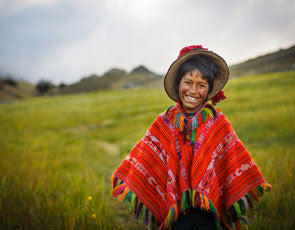I’ll begin this blog post by paying credit to its inspiration. Just this week, we were contacted by an interested party seeking more information about the beautiful woven poncho they had acquired. That’s simple enough right? Not necessarily. Our immediate thoughts were “What distinguishing features does the poncho have?” and “When, where and from whom was it purchased?” among others. We need that information because the weaving tradition is not only extremely widespread through Central and South America, but because in some countries, is thousands of years old.

The ponchos featured in our 2013-2014 Wholesale Catalog are slightly modern twists on ancient fashion, as featured here with our Jose Luis 100% Alpaca Poncho. Contact us for your own copy of our catalog!
That put me to thinking - I know a lot about the history of Peruvian textiles, my team members know a lot about the history of Peruvian textiles, but how much detailed information are we actually providing for our friends and potential customers about the very long historical trajectory that has inspired an entire movement for preservation and development? Well, we do our best but let’s dive in for some more details. After all, as an anthropologist and historian of South American culture myself, I can’t get enough of sharing facts and figures though I’ll still keep it short and sweet!
The cultural growth trajectory of Peru is something more complicated than many experts dare take on with short time allotments, let alone novices like myself. But in Layman terms, the country has been divided up into regional zones for the sake of organized study. In terms of textiles, we’re looking at the North (composed of the Moche, Chimu, Chavin and Huari cultures) and the South (proudly encompassing Paracas, Nazca, Ayacucho and Cusco). These were the pre-Inca dwellers, radiating from the coastal west, into the high Andes and westward into the lowland rainforest. They date as far back as 1000 BC and are some of the earliest and finest example we have of New World craftsmanship. And you thought the Incas were old?

An exquisite textile from the Paracas culture (c. 900 BC - 400 AD)

Another fine example of early weaving from Nazca, the coastal plain of southern Peru (c. 200 BC - 600 AD)
Fastforward! Apologies to my archaeology and history professors but I did promise to keep this brief. In the 16th century, 1532 to be exact, Francisco Pizarro and his band arrive in Peru and traditional clothing, as well as the Incan Empire, meet the faces of change. At this moment, more than 2,500 years after the first evidence of weaving in Peru, men and women are still wearing the traditional dress of their respective regions. However, after the introduction of Spanish fashion trends, regional dress began to incorporate new garments and styles, leaving many materials and garments only to memory.
However, some clothing articles from the pre-Incan and Incan periods have persisted and are still worn as daily dress in remote Peruvian communities, particularly in the Sacred Valley of Cusco. These include llicllas (women’s mantas or shawls), unkus (long shirts), ojotas (sandals, now made from rubber tires) and ponchos. Although these elements are also the result of continual change, in form, color and decorative elements, they still maintain the threads of thousands of years of history in their making.

These weavers from the remote Chaullaqocha community are pictured wearing traditional lliqullas (mantas) as well as ojotas (sandals)
Sadly, in recent years, traditional clothing has been gradually rejected, particularly by younger generations who have had more contact with urban and Western trends and lifestyles. It’s sincerely an astounding difference, to see adult men and women wearing woven shawls and ponchos while their children are seen in Western brand clothing. That is not to say that younger generations do not concern themselves with the importance and richness of their own culture because they certainly do, from participating in cultural festivals with traditional dance performances to maintaining the intimacy of their family life through learning to prepare traditional food and speaking Quechua. But the grand and rapid changes that are outlined here only serve to reinforce the importance of recognizing the unique beauty of woven textiles and the contribution that they have made and will continue to make to Peruvian history.
To bring us full circle, I’ll say that I have yet to find an answer for our poncho-information-seeker but if I’m able, it will certainly tell a tale of change and encounters spanning hundreds, perhaps thousands, of years. I will also tell him, as I will you all, that by making educated purchases and taking an interest in the investment, you are continuing to the continuation of these histories and the well-being of those to whom they pertain. That’s our mission at Threads of Peru and we thank you all for supporting us in it!
WIth special thanks to Nilda Callañaupa Alvarez, founder of the Center for Traditional Textiles in Cusco, for information gleaned from her book "Weaving in the Peruvian Highlands: Dreaming Patterns, Weaving Memories."

